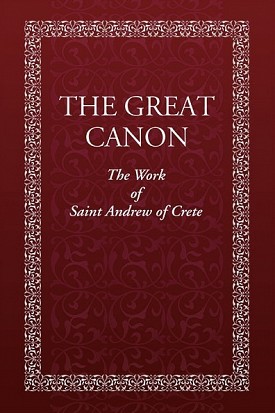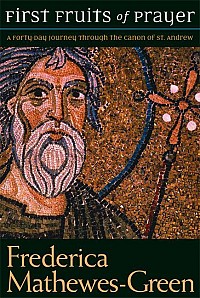GREAT LENT QUICK LINKS:
Great Lent I Pre-Lenten Period I Lenten Worship I On Fasting I On Confession
|
The Great Canon of St Andrew of Crete is chanted in the church Monday, Tuesday, Wednesday and Thursday evenings of the First Week, and also on Thursday of the Fifth Week together with the Life of St Mary of Egypt.
Please join us for this holy and compunctionate service.
|
There is no other sacred hymn which compares with this monumental work, which St Andrew wrote for his personal meditations. Nothing else has its extensive typology and mystical explanations of the scripture, from both the Old and New Testaments. One can almost consider this hymn to be a “survey of the Old and New Testament”. Its other distinguishing features are a spirit of mournful humility, hope in God, and complex and beautiful Trinitarian Doxologies and hymns to the Theotokos in each Ode.
The canon is a dialog between St. Andrew and his soul. The ongoing theme is an urgent exhortation to change one’s life. St Andrew always mentions his own sinfulness placed in juxtaposition to God’s mercy, and uses literally hundreds of references to good and bad examples from the OT and NT to “convince himself” to repent.
A canon is an ancient liturgical hymn, with a very strict format. It consists of a variable number of parts, each called an “ode”. Most common canons have eight Odes, numbered from one to nine, with Ode 2 being omitted. The most penitential canons have all nine odes. Some canons have only three Odes, such as many of the canons in the “Triodion” (which means “Three Odes”).
In any case, all Odes have the same basic format. An “Irmos” begins each Ode. This is generally sung, and each Irmos has a reference to one of the nine biblical canticles, which are selections from the Old and New Testament, which can be found in an appendix in any complete liturgical Psalter (book of Psalms, arranged for reading in the services). A variable number of “troparia” follow, which are short hymns about the subject of the canon. These are usually chanted, and not sung. After each troparion a “refrain” is chanted. At the end of each Ode, another hymn, called the “Katavasia”, either the Irmos previously sung, or one like it is sung.
The troparia of the Great Canon in all its twelve Odes are usually chanted by the priest in the center of the church, with the choir singing the Irmos and Katavasia. There are varying traditions about bows and prostrations. Some prostrate and some make the sign of the cross and bow three times after the Irmos and each troparion.
How we should think about ourselves
Desire to change—dialogue with the soul
Recognizing Reality
How to pray - Laments and supplications to God
Thou art the Good Shepherd; seek me, Thy lamb, and neglect not me who have gone astray. (Monday:3.5).
Old and New Testament examples of righteousness and unrighteousness, for the purpose of emulation or avoidance.
I have reviewed all the people of the Old Testament as examples for you, my soul. Imitate the God-loving deeds of the righteous and shun the sins of the wicked (Tuesday: Ode 8)
The most important thing to know about the Great Canon
Order the new edition of The Great Canon.
This is the classic canon of repentance, chanted in parts over the first four days of the Lenten Fast and in its entirety on the Thursday of the fifth week. The full text of the life of our Holy Mother Mary of Egypt is also given, as read liturgically during Matins on the Thursday of the fifth week. Traditional English translation.
This second edition uses the translation of Kallistos Ware and Mother Mary.
The complete text in PDF format as chanted on the first four days of Great Lent, and on Thursday of the Fifth Week.
More Lenten texts are available for download at http://www.orthodox.net/greatlent/
As we approach Great Lent, the time given to us specifically for repentance, the Church gives us a whole host of images to help us.
St. John of Kronstadt teaches that:
“Imagery or symbols are a necessity of human nature in our presently spiritually sensual condition; they explain [by the vision] many things belonging to the spiritual world which we could not know without images and symbols.”
We need pictures to help us think, to help us digest and understand the truths given to us. What St. Andrew of Crete does in the Great Canon written by him, is to being to remembrance many characters of the Old Testament and a few from the New Testament. In earlier times, people knew the scriptures much more than we do. Mention a name like Korah, Datham, Hophni or Phinehas and many people would be able to tell you all about them. When they heard these names in St. Andrew’s canon, they had the opportunity to be struck in the heart and brought to repentance. Unfortunately we are not that scripturally literate so the names can just fly by and not mean anything to us. We could be virtually untouched by the canon. The reason for this talk is to at least start us on the way to knowing to whom St. Andrew is referring.
However, we need to do more than simply know who all those people are. We need to take the canon personally. Their sins and failings are our sins and failings. That St. Andrew expects us to approach the canon personally is clear from the way he writes it.
Adam and Eve
The first people mentioned are, understandably, Adam and Eve. In Canticle One we read:
“I have rivaled in transgression Adam the first-formed man, and I have found myself stripped naked of God, of the eternal kingdom and its joy, because of my sins."
And:
“Instead of the visible Eve, I have the Eve of the mind: the passionate thought in my flesh, showing me what seems sweet; yet whenever I taste from it, I find it bitter.”
It is interesting that St. Andrew refers to Eve as the mind. There is a quote from St. Hesychius which reads: “If you make yourself fulfill [God's commandments] in thought, you will rarely find it necessary to toil over the fulfilling of them in action.”
So in the beginning of the canon, St. Andrew, through mentioning Adam and Eve tells us of the results of sin (separation from eternal life) and the cause of sin (turning from God in our thinking). St. John of Kronstadt teaches that we do not actually think with our mind. The thoughts we have are generated in our hearts, or are the result of suggestions by the devil. One of the things which the elder Simeon told the Mother of God was that her child “shall be spoken against, that the thoughts of many hearts may be revealed.”
In the prayer read at Midnight office on Sunday morning, there is a phrase which reads something like “I have become a slave to pleasure through slothfulness of mind.” I have even seen a warning on a bumper sticker which read, “Don’t believe everything you think”. If we believe everything we think, and, in our laziness, do not weigh our thoughts against the commandments of Christ, we become enslaved. By being aware of our thoughts, we can come to know what lies in our heart. We may not like what we come to know, but such is the spiritual life.
Perhaps the rest of the Old Testament figures mentioned in the canon could be seen as symbolizing the various ways in which we sin against God, in thought word, and deed.
To be further immersed in the Great Canon,
consider purchasing Frederica Mathewes-Green's book, First Fruits of Prayer: A Forty Day Journey through the Canon of St Andrew. Features daily commentary on the many scriptural and spiritual references.
NEW FOR 2022: Frederica discusses the Great Canon on her podcast...
In the author's words:
“First Fruits of Prayer is for anyone who wants to be stretched and challenged spiritually. It’s tough stuff. It seems to me that so much of contemporary Christianity is squishy and sentimental. It presents the faith like a consumer product, and is desperate to please. But go back 1000 or 1500 years, to a work like the Great Canon, and you don’t get that at all. There is a sense of awe and mystery here —a sense of *seriousness* — that you won’t find in a so-called 'praise chorus'.
"The Great Canon is demanding, no doubt about it. But maybe what we’re dealing with — life, death, evil, forgiveness, God’s compassion, our joy and gratitude — is serious, too.
"There are places where the theological understanding is different than it has historically been in Western Christianity. For example, sin is not seen so much as bad deeds which make God angry, and which require a payment (Christ’s blood) in order to be forgiven. Instead, St. Andrew speaks of sin as something that arises from deep inside, from a darkened and confused mind. It is like a self-inflicted wound. He speaks of God as all-compassionate, rushing toward us with healing love, like the Good Samaritan or the father of the Prodigal Son.
"So there’s no sense that God’s justice or honor have to be satisfied by Christ’s suffering before we can be forgiven. Christ’s suffering, instead, is the 'battle scars' of his fight to free us from Death and the Evil One.
"The concepts are more extreme on both sides. Sin is not just the breaking of external laws; it’s a poison that infiltrates our whole being and mind. Salvation is not just a 'legal fiction' that imputes righteousness we don’t really have; it is life “in Christ,” saturation in the lightbearing presence of God." (Source)
Available from Amazon.com, Light and Life, and Regina Press.


